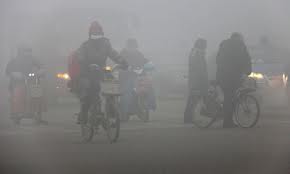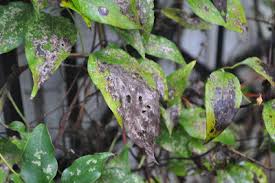Smog

Smog is a type of air pollution. The word "smog" was made in the early 20th century as a portmanteau of the words smoke and fog to refer to smoky fog.The word was then intended to refer to what was sometimes known as pea soup fog, a familiar and serious problem in London from the 19th century to the mid 20th century. This kind of smog is caused by the burning of large amounts of coal within a city; this smog contains soot particulates from smoke, sulfur dioxide and other components. Modern smog, as found for example in Los Angeles, is a type of air pollution derived from vehicular emission from internal combustion engines and industrial fumes that react in the atmosphere with sunlight to form secondary pollutants that also combine with the primary emissions to form photochemical smog. The atmospheric pollution levels of Los Angeles, Mexico City and other cities are increased by inversion that traps pollution close to the ground. It is usually highly toxic to humans and can cause severe sickness, shortened life or death.
How Did Smog Get Its Name?
The term "smog" was first used in London during the early 1900's to describe the combination of smoke and fog that often blanketed the city. According to several sources, the term was first coined by Dr. Henry Antoine des Voeux in his paper, “Fog and Smoke,” which he presented at a meeting of the Public Health Congress in July 1905. The type of smog described by Dr. des Voeux was a combination of smoke and sulphur dioxide, which resulted from the heavy use of coal to heat homes and businesses and to run factories in Victorian England.
Causes of Smog Acid Rain
Smog is produced by a set of complex photochemical reactions involving volatile organic compounds (VOCs), nitrogen oxides and sunlight, which form ground-level ozone. Smog-forming pollutants come from many sources such as automobile exhaust, power plants, factories and many consumer products, including paint, hairspray, charcoal starter fluid, chemical solvents, and even plastic popcorn packaging. In typical urban areas, at least half of the smog precursors come from cars, buses, trucks, and boats. Major smog occurrences often are linked to heavy motor vehicle traffic, high temperatures, sunshine, and calm winds. Weather and geography affect the location and severity of smog. Because temperature regulates the length of time it takes for smog to form, smog can occur more quickly and be more severe on a hot, sunny day.When temperature inversions occur (that is, when warm air stays near the ground instead of rising) and the wind is calm, smog may remain trapped over a city for days. As traffic and other sources add more pollutants to the air, the smog gets worse. Ironically, smog is often more severe farther away from the sources of pollution, because the chemical reactions that cause smog take place in the atmosphere.
Effects on Smog on Plants
Industries often have smog, which is a byproduct of industrial processes. This smog has a detrimental effect on human health, damages property and harms overall ecological systems. However, smog has the most detrimental effect on plants, which are completely wiped out in heavily polluted areas and struggle to survive in less smoggy areas. The loss of plant life through smog not only harms the environment, but takes a tremendous toll on agriculture and the economy.
Acid Rain Ozone
Smog creates acid rain, which can cause property damage and has a detrimental effect on human health. However, acid rain is also devastating to plants, killing some and leaving other badly damaged, according to the University of California.
Ozone Diminished Photosynthesis
Ozone and peroxyacetyl nitrate that travel close to the ground as a result of smog can have damaging effects on plants, resulting in the discoloration and damage to plants. This reduces the amount of photosynthesis that these plants can engage in, according to the University of California. Photosynthesis is the primary way in which plants receive energy; the loss in the ability to absorb sunlight can cause the growth of plants to be stunted.
Diminished Photosynthesis
Plants that are unable to engage in photosynthesis and other crucial life processes will also struggle to reproduce, which might cause certain species of plant life to be permanently eliminated from certain areas unless human intervention occurs, according to the University of California. These plants also lose the ability to store food, which makes them further vulnerable to death. Smog weakens plants, which makes them more susceptible to diseases and pests that can do further damage, according to the University of California.
Economic Hardship
The countries that suffer the most from pollution also produce the most food, which suggests reducing the amount of smog could dramatically increase the amount of food produced worldwide, according to the University of California. The food that isn’t destroyed by smog is often discolored and has less nutrients, which hurts the farming industry, according to the South Coast Air Quality Management District. Smog reduction would also increase property values in areas with high amounts of smog, since these properties would have healthier trees.
Smog can cause a plant to lose 10 to 40 percent growth, according to the University of California. Agriculture loses 2 to 6 billion dollars a year as a result of reduced productivity caused by smog. In response, legislation has been passed, such as the Clean Air Act Amendments, which are predicted to save 4 billion dollars in lost agricultural productivity. Ozone monitors have also been installed in areas with struggling plant growth in order to track the spread of smog in these areas, according to South Coast Air Quality Management District.
How to Detect Smog ?
Smog is a visible form of air pollution that often appears as a thick haze. Look toward the horizon during daylight hours, and you can see how much smog is in the air. In addition, most cities now measure the concentration of pollutants in the air and provide public reports—often published in newspapers and broadcast on local radio and television stations—when smog reaches potentially unsafe levels. The U.S. Environmental Protection Agency (EPA) has developed the Air Quality Index (AQI) (formerly known as the Pollutant Standards Index) for reporting concentrations of ground-level ozone and other common air pollutants. Air quality is measured by a nationwide monitoring system that records concentrations of ground-level ozone and several other air pollutants at more than a thousand locations across the United States. The EPA then interprets that data according to the standard AQI index, which ranges from zero to 500. The higher the AQI value for a specific pollutant, the greater the danger to public health and the environment.

